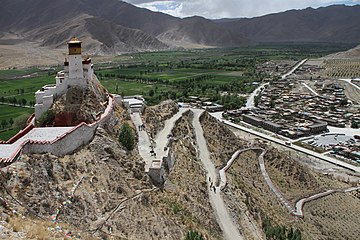| Yungbu Lakhang Palace | |
|---|---|
| ཁྲ་འབྲུག་དགོན་པ | |
 The restored Yumbu Lakhang The restored Yumbu Lakhang | |
| Religion | |
| Affiliation | Bön |
| Location | |
| Location | Lhoka, Tibet Autonomous Region, China |
 | |
| Geographic coordinates | 29°08′33″N 91°48′10″E / 29.14258°N 91.80270°E / 29.14258; 91.80270 |
| Architecture | |
| Demolished | 1966 |
Yumbu Lakhang (Tibetan: ཡུམ་བུ་བླ་སྒང།, Wylie: yum bu bla sgang; Chinese: 雍布拉康) or Yumbu Lakhar (Tibetan: ཡུམ་བུ་བླ་མཁར།, Wylie: yum bu bla mkhar, also known as Yumbu Lakhang) is an ancient structure in the Yarlung Valley in the vicinity of Tsetang, Nêdong County, the seat of Lhoka Prefecture, in Tibet.
According to legend, it was the first building in Tibet and the palace of the first Tibetan king, Nyatri Tsenpo. Yumbu Lakhang stands on a hill on the eastern bank of the Yarlung River in the Yarlung Valley of southeast Nêdong County about 192 kilometres (119 mi) southeast of Lhasa and 9 kilometres (5.6 mi) south of Tsetang.
History
According to Tibetan traditions, Yumbu Lakhang was built for the first Tibetan king, Nyatri Tsenpo, who descended from the sky with his grandmother. It was probably built around the 2nd century BCE, since king Nyatri started to rule in 127 BCE. During the reign of the 28th king, Thothori Nyantsen, in the fifth century AD, a golden stupa, a jewel (and/or a form to the manufacture of dough-Stupas) and a sutra that no one could read fell from the sky onto the roof of the Yumbu Lakhang; a voice from the sky announced, "In five generations one shall come that understands its meaning!" Later, Yumbu Lakhang became the summer palace of the 33rd Tibetan king, Songtsen Gampo (604-650 AD) and his Chinese princess, Wencheng. After Songtsen Gampo had transferred the seat of his temporal and spiritual authority to Lhasa, Yumbu Lakhang became a shrine.
A thousand years later, during the reign of the 5th Dalai Lama (1617-82), the palace was turned into a monastery for the Gelug school.
The Yumbu Lakhang was heavily damaged and reduced to a single storey during the Cultural revolution but was reconstructed in 1983.
As of November 2017 the palace is undergoing $1.5m of restoration works to reinforce its crumbling wooden foundations and cracked walls. It was expected to reopen to the public in April 2018.
-

-
 Stupa
Stupa
-

-
 prayer flags on the path to Yumbulagang
prayer flags on the path to Yumbulagang
-

-
 Pitchfork of Death at Yumbulagang
Pitchfork of Death at Yumbulagang
Interior
The castle is divided into front and rear precincts. The front is a three-storey building while the rear is dominated by a tall tower, like a castle. Enshrined at the palace are the statues of Thiesung Sangjie Buddha, King Niechi, the first King of Tibet, Songtsen Gampo and other Tubo kings.
Zorthang
Traditionally, the largest cultivated area in Tibet, called Zorthang, is located to the northwest, below Yumbu Lakhang. Even today, farmers sprinkle soil from Zorthang on their own fields to ensure a good harvest. There used to be a temple, Lharu Menlha, containing images of the Eight Medicine Buddhas near the area.
Footnotes
- "Places»Place Types»Sites»Palace»yum bu bla mkhar/". Tibetan Buddhist Research Center. Retrieved 11 November 2014.
- Mayhew (2005), p. 153.
- Khenchen Palden Sherab Rinpoche: The Eight Manifestations of Guru Padmasambhva Archived 2005-01-21 at the Wayback Machine (ratna.info)
- Eva M. Dargyay: The Rise of Esoteric Buddhism in Tibet (Delhi, Motinal Banarsidass 1979), ISBN 81-208-1577-7, S. 4.
- Dowman (1988), p. 180.
- ^ Dorje (1999), p. 195.
- Victor Chan, Tibet. Guide du pèlerin, Éditions Olizane, Genève, 1998, p. 590 : "L'actuel Yumbu Lagang est une reconstruction (1982) du bâtiment originel, preque totalement détruit pendant la Révolution culturelle. Sa tour fut si gravement endommagée que seul un morceau de sa base demeura en place".
- "Tibet's oldest palace to undergo reconstruction work". FINDCHINA.
References
- Buckley, Michael and Strauss, Robert. Tibet: a travel survival kit. (1986) Lonely Planet Publications, Victoria, Australia. ISBN 0-908086-88-1.
- Das, Sarat Chandra. (1902). Lhasa and Central Tibet. Reprint: (1988). Mehra Offset Press, Delhi.
- Dorje, Gyume (1999). Footprint Tibet Handbook with Bhutan. Footprint Handbooks, Bath, England. ISBN 0-8442-2190-2.
- Dowman, Keith. (1988) The Power-Places of Central Tibet: The Pilgrim's Guide. Routledge & Kegan Paul, London & New York. ISBN 0-7102-1370-0.
- Mayhew, Bradley and Kohn, Michael. (2005) Tibet. 6th Edition. ISBN 1-74059-523-8.
- ngag dbang blo bzang rgya mtsho: bod kyi deb ther dpyid kyi rgyal mo’i glu dbyangs. Kapitel 2 und 3. Übersetzung von Zahiruddin Ahmad ins Englische: A History of Tibet by the Fifth Dalai Lama of Tibet (Bloomington, Indiana University 1995), ISBN 0-933070-32-2.
- nor brang o rgyan: gangs can yul gyi sa la spyod pa’i mtho ris kyi rgyal byon gtso bor brjod pa’i deb ther rdzogs ldan gzhon nu’i dga' ston dpyid kyi rgyal mo’i glu dyangs-kyi ’grel pa yid kyi dga’ ston (Beijing, mi rigs dpe skrun khang / Mínzú chūbǎnshè 民族出版社 1993), ISBN 0-933070-32-2.
- History of Tibet – A Few Chapters (Part 1) Archived 2019-08-12 at the Wayback Machine
- "The ancient hilltop palace Yumbu Lhakhang, Tibet's oldest building". National Geographic Creative.
External links
- Yum bu bla sgang Archived 2008-04-11 at the Wayback Machine (Tibetan and Himalayan Digital Library)
| Dzongs of Tibet | |
|---|---|




